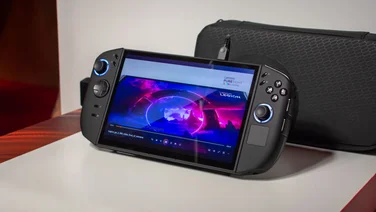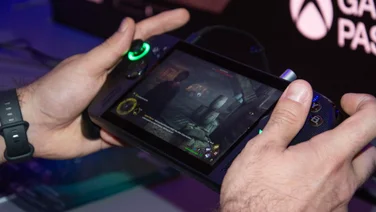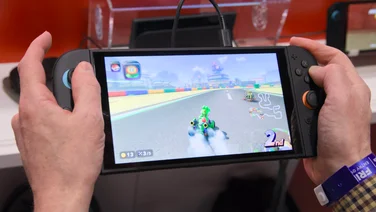To help us provide you with free impartial advice, we may earn a commission if you buy through links on our site. Learn more

For those planning to buy a PS4, you’ll be confronted with numerous options. Modern consoles vary in size, power and capabilities, and that’s before you’ve considered special editions or optional extras. They look very similar, too: telling your PS4 apart from your PS4 Pro is, frankly, a daunting task for those who aren’t clued up on the 2019 console market.
All of this makes deciding which to buy a tricky decision, so we thought we’d make your life easier. This guide will take you through the most important differences between a PS4 and a PS4 Pro, hopefully helping to make it easier for you to come to a decision.
READ NEXT: Our PS4 Pro review
PS4 Pro vs PS4: What do they look like?
This is perhaps the most important question to ask, particularly if you’re not buying a brand-new unit. Let’s break it down by console.
PS4

The original PS4 – released in 2013 – is easily identified by its angular, slanted shape and double-decker arrangement. The very first models were matte black, with a glossy black faceplate that was separated from the rest of the machine by an LED strip that ran the length of the console. This faceplate could slide away, revealing the PS4’s mounted hard drive. A white version followed, along with a number of limited edition versions including the very swanky 20th Anniversary edition matching the grey tones of the original PlayStation.
PS4 Slim

The 2016 PS4 Slim is more soft-edged, smaller and lighter than its predecessor, but otherwise similar-looking. There’s no dividing strip of LEDs, or removable section, but a shiny PlayStation logo sit on the console’s top.
PS4 Pro

The easiest way to identify the PS4 Pro is by counting the layers. The Pro is a triple-decker machine, and closer in shape to the PS4 Slim than the original PS4. It’s weighty, and is also significantly bigger than either of its siblings. An LED strip runs horizontally along the front face of the console, lighting the disc drive and power/eject buttons. There haven’t been many notable changes to this console, but Sony did recently release an absolutely gorgeous limited edition PS4 Pro to mark 500 million PS4 units sold.
PS4 Pro vs PS4: How much do they cost?
The original PS4 Pro and original PS4 both launched at £349, while the PS4 Slim (which was replacing the latter) came in at £259.
The old, angular PS4 is harder to find these days, but will always be the cheapest of the three, particularly the 500GB model. The PS4 Slim can currently be purchased for between £200-£300, depending on the bundle. The PS4 Pro, on the other hand, has yet to see a real price reduction and remains stubbornly at £350.
READ NEXT: How to buy a refurbished PS4
PS4 Pro vs PS4: What can you play on them?
Games
There’s no difference between the games libraries for the PS4 and PS4 Pro. Most modern games advertise that they’re “PS4 Pro Enhanced”, which usually means they offer a higher resolution (sometimes hitting the gaming nirvana of 4K), more detail or just a smoother frame rate. Otherwise, you’ll find that the entire catalogue of PS4 games can be played on either console without issue.
PSVR
PlayStation Virtual Reality is compatible with all three consoles – and, again, there’s no difference in the library of games on offer. However, what you will find is that the intelligent game developers out there have made full use of the PS4 Pro’s added grunt; VR games played on PS4 Pro often look and run better than those played on the standard machines.
PS4 Pro vs PS4: What can they do?
If you’re in the market for a PS4, this is the bit that matters the most.
PS4
In 2013, when the PS4 first launched, it was lauded for its snappy user interface and remarkable processing power. The PS4 is capable of running games and videos at a maximum 1080p resolution – that’s Full HD, or the normal resolution for your living room TV. In addition, the new Dualshock 4 controller, complete with touchpad and ergonomic rear bumpers, represented a huge step up from the cheap plastic of the PS3.
The PS4 has a built-in Blu-ray player, and access to social media, streaming services such as Netflix and Amazon Prime Video, and web browsing. It has an easily-accessed hard drive, which allows even the most technologically challenged to upgrade their storage device and load even more games into their console. Although, since version 4.5 of the PS4 firmware, external hard drives have been supported, so there’s less need to get your hands dirty anyway.
PS4 Slim
The Slim packs everything I’ve just mentioned into a smaller, lighter case. It also introduces an updated Dualshock 4 that improves the durability of the thumbstick and adds a thin strip to the touchpad through which the controller’s LED light is visible. The Slim was the first standard PS4 to offer support for HDR (high dynamic range), which provides a greater depth of colour on supported games with compatible TVs. This feature was eventually added to the original PS4 in the 4.0 firmware update.
Furthermore, the PS4 Slim offers 5GHz Wi-Fi compatibility. It isn’t something that many folk will take conscious advantage of, but it does help speed up downloads and, in some instances, help reduce in-game network lag.
PS4 Pro
The PS4 Pro is the most powerful console Sony has ever produced. It can run games at 1080p, 1440p, and 2160p (that’s 4K to you), which is the console’s primary selling point. Provided you have a 4K monitor/TV, you’ll notice an immediate improvement to the vast majority of games.
Older titles often feature basic upscaling (from 1080p to 1440p), and newer ones support a host of advanced graphical options. Games will appear more crisp and detailed, with enhanced lighting, effects and general object textures. The most recent releases often offer a few different settings that allow you to prioritise frame rates (how smoothly the game runs), resolution (how crisp it looks) or detail (how many objects the game loads).
Even if you don’t have a 4K TV, the PS4 Pro’s Boost mode will do what it can to improve the look or feel of any game. You’ll also be able to stream movies and TV shows in 4K, although the Pro doesn’t support 4K Blu Rays, unlike the Xbox One S and Xbox One X. Otherwise, the PS4 Pro doesn’t offer a huge amount more than the standard PS4; it uses the same user interface, and features the same updated controller as the PS4 Slim. However, it will feel a little speedier, courtesy of that added muscle under the hood.
PS4 Pro vs PS4: Tech specs side-by-side
For those of you with an understanding of technical jargon, here’s a table that compares the specifications of the PS4 and PS4 Pro.
| Specifications | PS4 | PS4 Pro |
| CPU | AMD Jaguar eight-core 1.6GHz | AMD Jaguar eight-core 2.1GHz |
| GPU | AMD Radeon 1.8 TFLOPS | AMD Radeon 4.2 TFLOPS |
| Memory (RAM) | 8GB GDDR5 VRAM | 8GB GDDR5 VRAM + 1GB DDR3 RAM |
| Storage | 500GB/1TB HDD | 1TB HDD |
| Ports | 2 x Super-Speed USB3.1 1 x AUX port 1 x HDMI (HDR) 1 x Ethernet | 3 x Super-Speed USB3.1 1 x AUX port 1 x HDMI (4K/HDR) 1 x Ethernet 1 x Digital optical |
If you take away nothing else from this table, let it be the fact that the numbers are bigger in the “PS4 Pro” column.
There you have it – provided your head isn’t spinning, you now know just about everything that differentiates the PS4 from the PS4 Pro. If you’re after high-quality, high-cost console gaming on a 4K TV, then the PS4 Pro is the console for you; if you just want a console on which your kids can play Minecraft, then stick to the PS4 or PS4 Slim.










